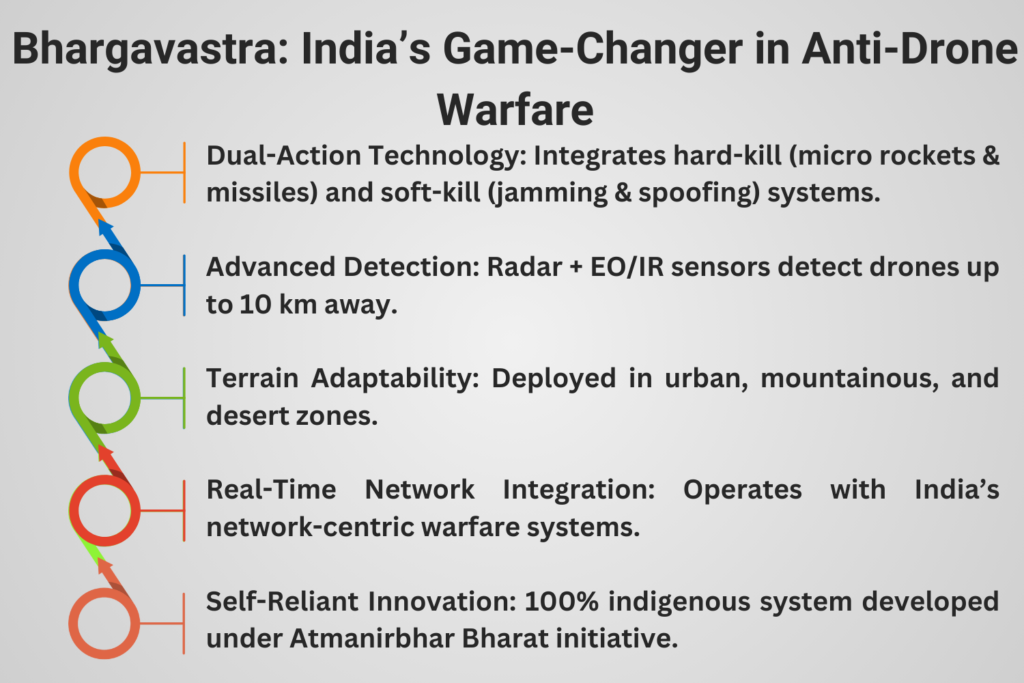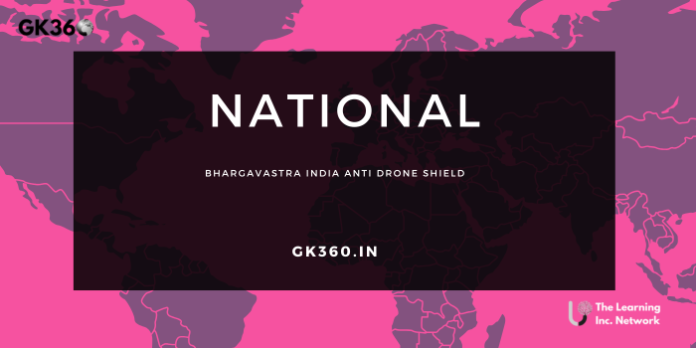Bhargavastra: India’s Advanced Indigenous Anti-Drone Weapon System for Swarm Defence
India has achieved a significant milestone in defence innovation with the successful test-firing of Bhargavastra, a next-generation anti-drone weapon system developed by Solar Defence and Aerospace Limited (SDAL). Designed to neutralize complex drone swarm threats, Bhargavastra integrates hard-kill and soft-kill capabilities into a powerful indigenous platform. In an era of evolving aerial warfare and increasing cross-border drone incursions, this successful test marks a major leap in India’s self-reliant defence technology and national security preparedness.

Table of Contents
- Why Bhargavastra’s Test-Firing Matters in 2025
- Strategic Goals of India’s Anti-Drone Technology
- Understanding the Drone Swarm Threat in Modern Warfare
- Bhargavastra’s Features: Hard-Kill, Soft-Kill, and Detection Capabilities
- Why Bhargavastra is a Game-Changer in India’s Defence Landscape
- FAQs About Bhargavastra and India’s Drone Defence
- Conclusion
Why Bhargavastra’s Test-Firing Matters in 2025
The successful test of Bhargavastra couldn’t have come at a more critical time. With drone swarm warfare becoming a key strategy in modern conflict, India has faced increasing aerial intrusions—particularly from Pakistan-operated drones, including imported kamikaze UAVs. These incursions target sensitive military zones and highlight the limitations of traditional air defence systems.
Bhargavastra offers a homegrown, high-tech solution to such threats. Its trial success sends a clear message: India is ready to counter next-gen aerial warfare with indigenous innovation. The deployment of Bhargavastra enhances not only national security but also reflects a strategic shift toward autonomous, AI-supported combat systems.
Strategic Goals of India’s Anti-Drone Technology
Bhargavastra was conceived with a clear mission: to address the tactical gaps in India’s current defence against unmanned aerial vehicles (UAVs). Here are the core strategic objectives behind its development:
- Indigenous Capability Building: Bhargavastra supports the Atmanirbhar Bharat (Self-Reliant India) vision by reducing reliance on foreign anti-drone technologies.
- Layered Defence Architecture: It integrates hard-kill (direct destruction) and soft-kill (electronic warfare) methods for comprehensive threat neutralization.
- Terrain Agility: The platform is adaptable to various terrains—from urban environments to high-altitude zones.
- Network-Centric Integration: Bhargavastra connects with India’s advanced warfare systems, enabling real-time threat identification and response.
This strategic blend of technology, agility, and connectivity ensures that the system is both future-ready and effective across a wide range of combat scenarios.
Understanding the Drone Swarm Threat in Modern Warfare
Drone swarms—groups of small UAVs operating autonomously and in coordination—have emerged as one of the most disruptive forces in military strategy. These swarms can:
- Overwhelm radar and defence systems
- Use AI-powered navigation for multi-vector attacks
- Deploy decoy drones to distract or confuse security responses
- Conduct high-precision strikes with minimal cost
India’s geopolitical context makes this threat even more urgent. Cross-border incursions by hostile drones have become frequent, particularly near military zones in Punjab and Jammu. These attacks have involved foreign-supplied kamikaze drones, raising alarms about India’s drone vulnerability.
Bhargavastra is a direct response to these developments—offering autonomous, adaptive, and multi-layered protection against this rapidly evolving threat.
Bhargavastra’s Features: Hard-Kill, Soft-Kill, and Detection Capabilities
Bhargavastra’s advanced multi-layered design brings together offensive and defensive technologies to form a versatile anti-drone system. Here are its standout components:
1. Hard-Kill System
- Micro Rockets: Unguided and highly effective, these can neutralize drones within a 20-meter lethal radius, with an operational range of up to 2.5 km.
- Purpose: Ideal for dense drone formations and rapid, high-impact responses.
2. Precision-Guided Missiles
- Targets high-value drones, such as command-and-control UAVs or camouflaged swarm leaders.
- Ensures pinpoint accuracy in destroying individual drones within a formation.
3. Soft-Kill System
- Employs Electronic Warfare (EW) tools:
- Jamming: Disrupts radio frequencies controlling drones.
- Spoofing: Sends false GPS signals, leading drones off course or causing them to crash.
- Advantage: Non-lethal neutralization that preserves surrounding infrastructure.
4. Detection Capabilities
- Radar Coverage: Detects drones at 6–10 km, providing early threat warnings.
- EO/IR Sensors: Capable of identifying stealth UAVs and micro-drones with low radar visibility.
- Together, these systems offer 24×7 threat surveillance and layered protection.
5. Mobility and Terrain Compatibility
- Bhargavastra is modular and mobile, allowing deployment in:
- Mountainous regions (Ladakh, Sikkim)
- Desert zones (Rajasthan)
- Urban installations (airports, defence bases)
- The system can be mounted on a range of platforms—static posts, mobile vehicles, or high-altitude stations.
6. Network Integration
- Fully interoperable with India’s network-centric warfare ecosystem.
- Enables real-time communication with other command systems and radar networks, allowing simultaneous multi-threat engagements.
Why Bhargavastra is a Game-Changer in India’s Defence Landscape
The test-firing of Bhargavastra marks more than just a technological milestone. It represents a paradigm shift in India’s defensive doctrine:
- Boosts Defence Manufacturing: Solidifies India’s capacity to develop indigenous advanced warfare systems.
- Secures Critical Infrastructure: Ideal for protecting military bases, nuclear sites, government buildings, and urban airspace.
- Improves Response Time: AI-aided tracking and integrated decision loops reduce reaction delays during drone attacks.
- Supports Export Potential: Bhargavastra can be positioned for export to allied nations, enhancing India’s standing in the global arms market.
- Cost-Efficient: Domestic R&D ensures a lower procurement cost compared to foreign anti-drone systems.

FAQs About Bhargavastra and India’s Drone Defence
- What is Bhargavastra?
Bhargavastra is an indigenous Indian anti-drone weapon system developed by Solar Defence and Aerospace Limited. It combines hard-kill and soft-kill methods to neutralize swarm drone threats. - How does Bhargavastra detect drones?
It uses radar (6–10 km range) and EO/IR sensors to detect stealth and micro-UAVs, ensuring early identification and accurate targeting. - What makes Bhargavastra different from imported systems?
It is a modular, terrain-adaptable, and cost-effective system tailored for India’s geographical and strategic needs—unlike many imported solutions designed for flat terrain or limited threat profiles. - Is Bhargavastra deployable in high-altitude areas like Ladakh?
Yes, it is specifically designed for high-altitude and harsh terrain conditions, enhancing India’s defence capabilities at border flashpoints. - Can Bhargavastra be used during peacetime?
Absolutely. It can safeguard civilian airspaces, such as airports and urban centers, from unauthorized drone surveillance or attacks.
Conclusion
The launch and testing of Bhargavastra signals a turning point in India’s defence strategy. With drone warfare rising globally, Bhargavastra gives India the technological edge to defend, deter, and dominate in the face of modern aerial threats. Built with Indian expertise and tailored for Indian conditions, it is both a symbol of self-reliance and a weapon of strategic necessity.
Bhargavastra isn’t just a weapon—it’s a vision of India’s defence future, where autonomous technologies, indigenous solutions, and smart warfare converge.
Key Takeaways Table
| Aspect | Details |
| Purpose | Neutralizes modern drone swarm threats through hard-kill and soft-kill systems. |
| Strategic Objective | Achieve self-reliance in defence (Atmanirbhar Bharat) & strengthen airspace security. |
| Key Technologies | Micro rockets, guided missiles, radar, EO/IR sensors, jamming & spoofing tools. |
| Deployment Versatility | Modular system deployable across urban, desert, and high-altitude regions. |
| Threat Detection Range | Radar coverage up to 10 km with real-time alert systems. |
| AI & Network Integration | Enables automated tracking and threat mitigation through command network links. |
| Significance in 2025 Context | Responds to increasing hostile drone incursions from neighboring territories. |





